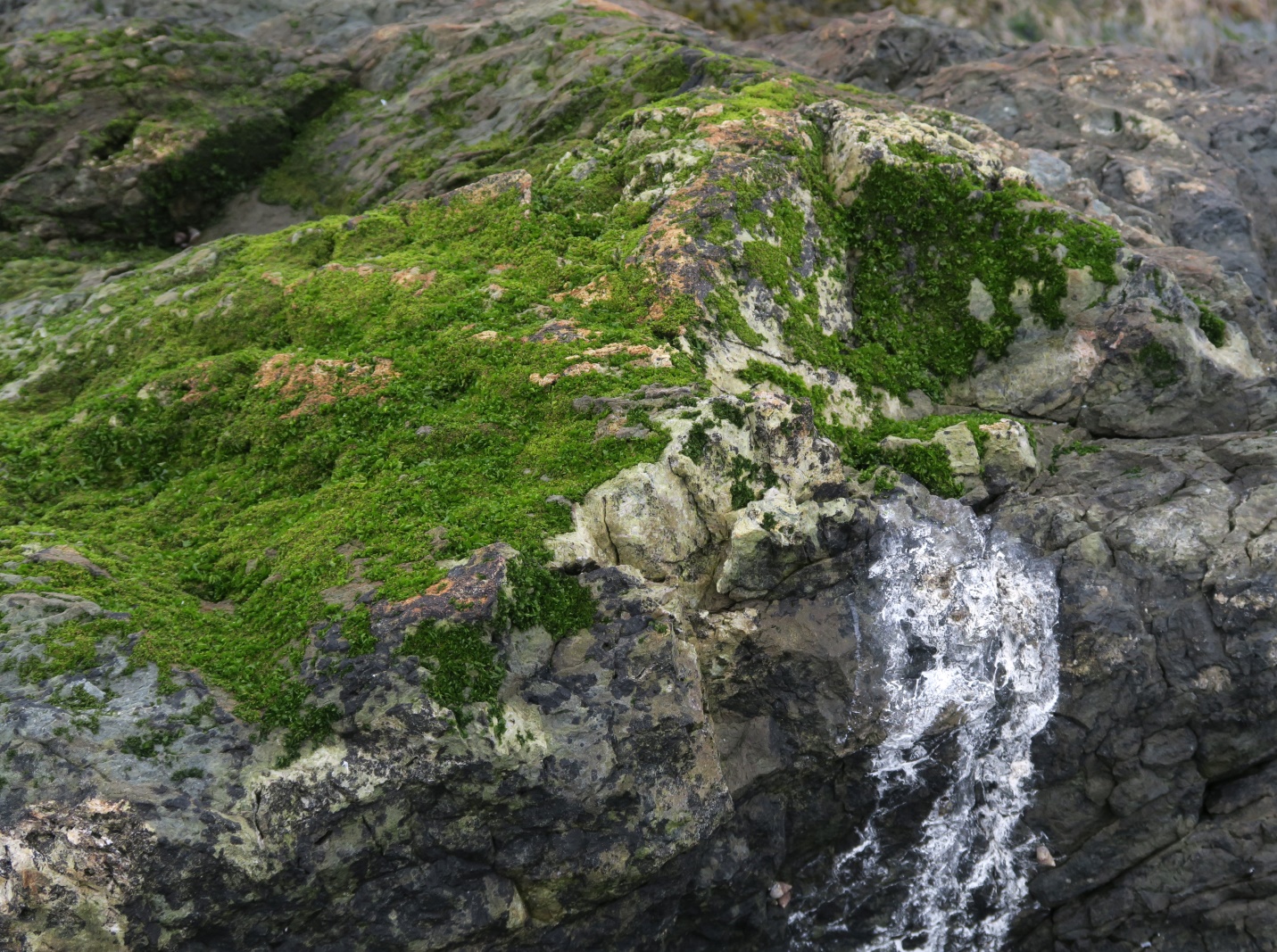
Prasiola meridionalis
Emerald Carpet, Bird Guano Seaweed, Short Sea Lettuce
On site interactions: 12 June 2021
Harling Point, Juan de Fuca Strait
Tide: 1.0 foot tide 11:28 am PDT (measured at Oak Bay Tidal Station)
Conditions: Mostly clear sky, no precipitation, wind NE 5 – 10 km/hr, sea calm, 15˚C.
Phase of Moon: Waxing Crescent (approx. 55 hours into this phase at time of interaction); (Previous Phase, New Moon, 10 June 2021 at 3:52am PDT: Next Phase, First Quarter, 17 June 2021 at 8:54pm PDT.)
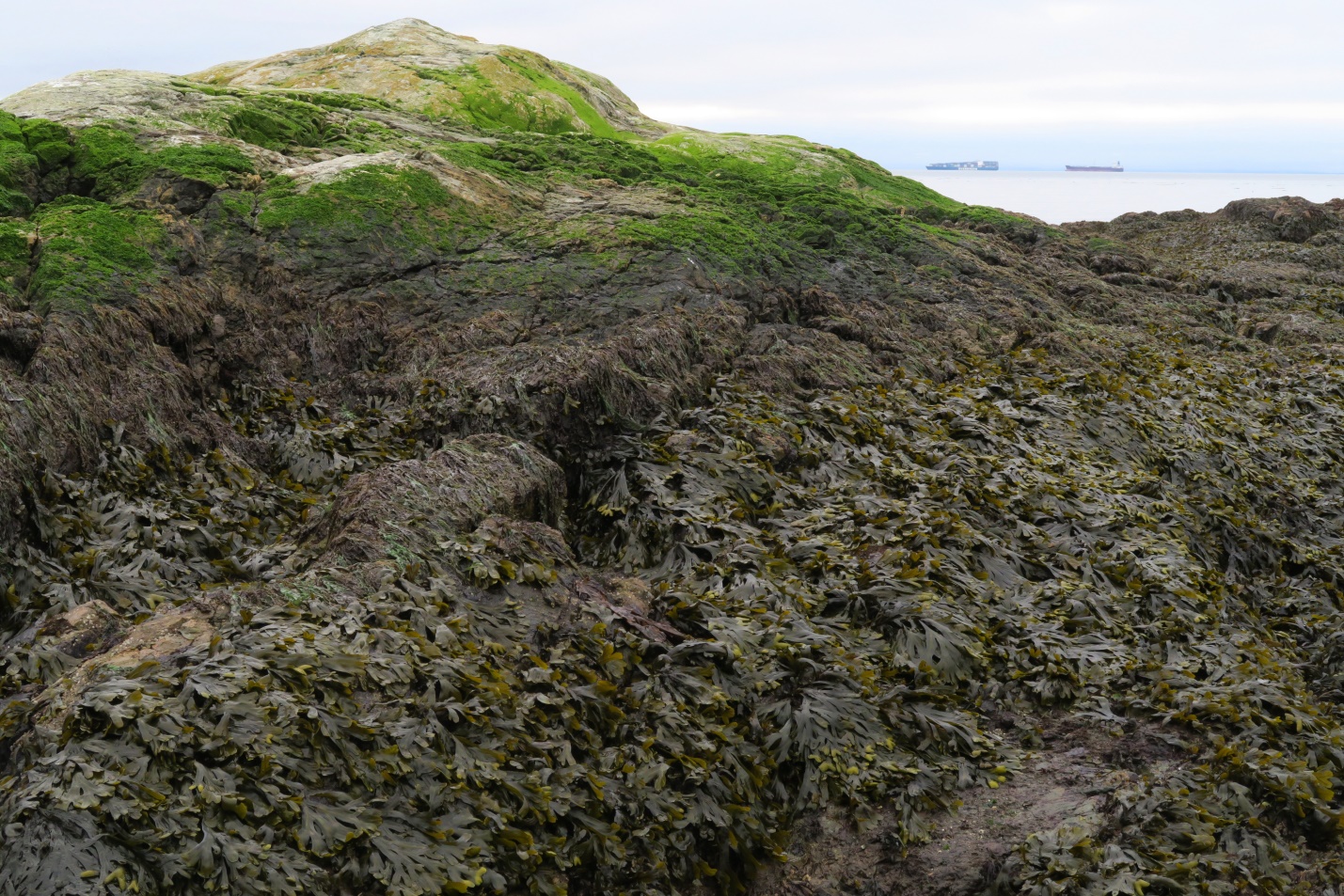
Figure 1: Highest of the high intertidal habitat seaweeds in our region, the coating of green atop this rock, situated even above the carpet of Fucus distichus, is comprised of the bright green seaweed Prasiolia meridionalis. Gonzales Bay, Juan de Fuca Strait, B.C., Canada. February 10, 2022. Photo ID 27445 ©Seaweedwhisperings.com
Person 1:
Shares a “bird’s eye view” of the world, sitting atop a rock where only spray and highest storm waves reach.
Very good at waiting, but may not know what it’s waiting for.
Bright green.
Looks soft, but is very tough to the touch when dry. It is soft when wet – rehydrates quickly?
Keeps a low profile to resist totally drying up.
It’s exposed to the sun all the time.
Gets many visitors – loafing gulls, oyster catchers, river otters (pieces of a large kelp crab eaten by an otter were left adjacent to our seaweed patch).
Receives visitors but doesn’t really interact with them.
The only other permanent resident here is a black marine lichen.
Needs guano, but can it take a direct hit?
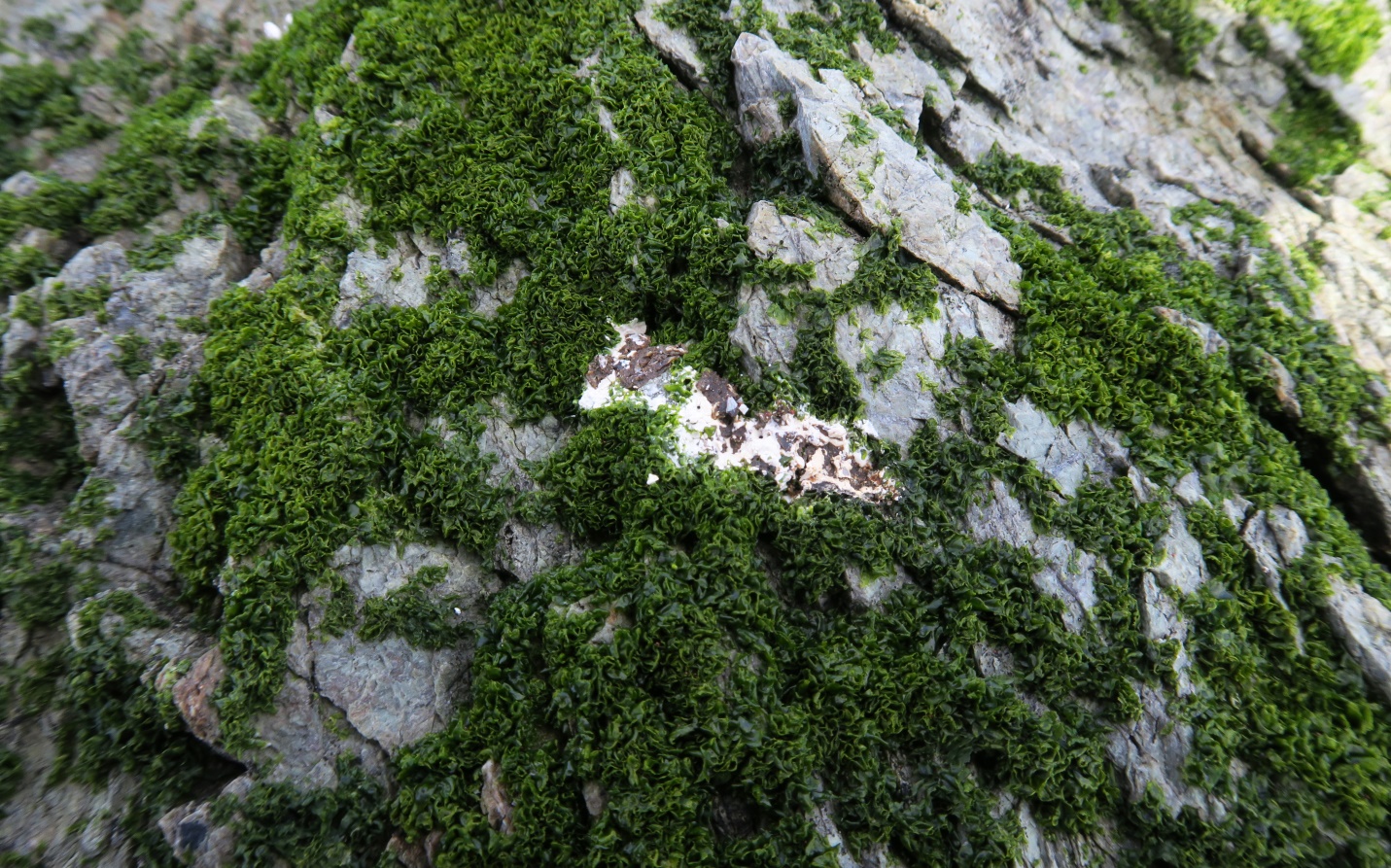
Figure 2: Prasiola meridionalis, Bird Guano Seaweed, is pictured here with a fresh deposit of nitrogen rich guano Harling Point, Juan de Fuca Strait, B.C., Canada. June 12, 2021. Photo ID 27446 ©Seaweedwhisperings.com
Figure 3: Another typical setting for Emerald Carpet – the splash of white suggests that rock edge here is likely to be a favorite perch for a Glaucous-winged Gull or similar avian species. Gonzales Bay, Juan de Fuca Strait, B.C., Canada. August 31, 2020. Photo ID 27447 ©Seaweedwhisperings.com
Person 2:
Atop the highest exposures of the bedrock you flourish.
Bright “lawn” green – like the manicured golf course putting greens.
Uniform-looking in height and green, oh so green!
Sitting here with you I smell the rotting bits of the kelp crab that a gull likely dined on here recently and as is befitting an active digestive system the gull also defecated here – on you!
Nutrients are thereby delivered to you at your outpost farthest from the nourishing ocean waters. How perfectly clever – nothing goes to waste in the cycle of life.
When I look at your tiny blades, they are simple ovals or rounded shapes that curl inward.
That curl probably helps you holds moisture and it ads “dimension” to you – an alga of very small dimensions.
You can do without, without guano, and without even ocean spray – and you endure, but when you do have water and nutrients do you “dine out” like a starving man?
No, it feels as if you use your resources steadily and patiently.
You have only so much capacity.
Very wet groupings of you are slippery and my finger slides off as if from buttered noodles. Drier areas feel more like a very short fibred carpet, and the driest feel papery and stiff.
You can you “fill up” but you’re so small that fullness isn’t really a lot.
The crevices of the bedrock, even the smallest ones, give you a bit better circumstance – a place to store a few necessities, AND from there you can crawl and advance over the rock.
Cheerful.
Openly content.
Uncomplicated.
Happy in its place – unaware even that it could be lonely here (in contrast with the crowded intertidal areas with a multitude of neighbors).
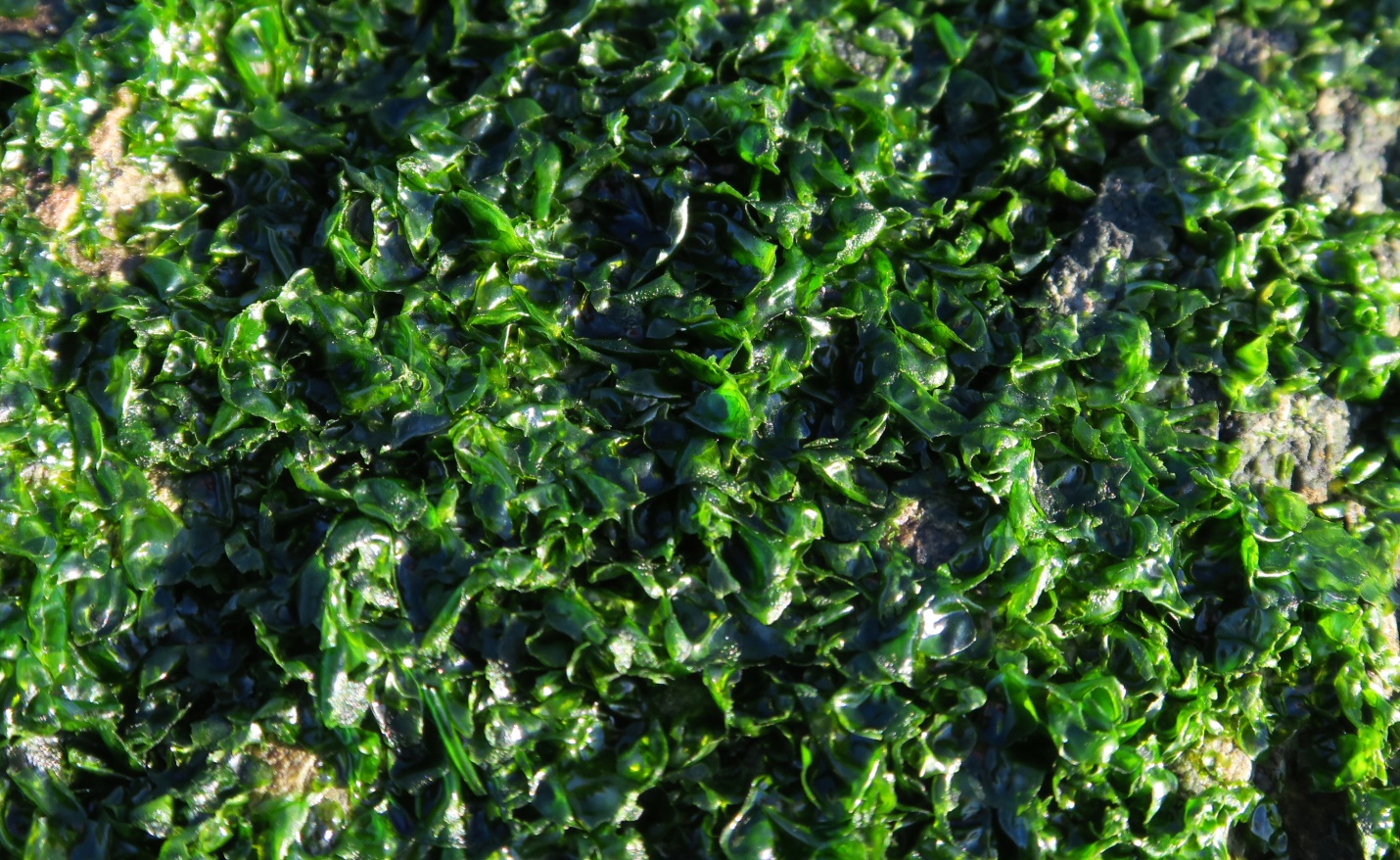
Figure 4: Much larger than life size, this photo shows the Emerald Carpet “green” hue very well and also it’s curved or hood-like form. This look, especially the thin green blade texture, is also most similar to some sea lettuces which belong to the genus Ulva, hence one of the common names for Prasiola meridionalis is Short Sea Lettuce. Harling Point, Juan de Fuca Strait, B.C., Canada. January 22, 2021. Photo ID 27448 ©Seaweedwhisperings.com
Discussion:
As an algae that can thrive in the high intertidal and above the high tide line, Prasiola meridionalis seems to be possibly just barely engaging with the possibility of life more closely immersed in the sea. Maybe it has only “one toe in the water” and is happy to be like that. It’s not ready to go further, and in its simple contentedness, sees no reason to go further either. Possibly it could be easier to grow with a more regular supply of nourishing seawater, but maybe that is too hard to achieve; the competition is too stiff down there. So Emerald Carpet has almost accidentally found that it will embrace the offerings of being “near to” the sea – the ocean spray and the ‘deposits’ of guano that seabirds leave. This proves to be quite enough, so why not enjoy it!!
Way up high with its “bird’s eye view” one could think this seaweed is lonely or outside of the group as it is really quite isolated from other macroalgae. Person 1 felt it may be “waiting”, but for what, it does not yet know. Waiting in this place, however, doesn’t feel as if it is experienced as a hardship. Instead it gives time to play and to imagine and to dream.
Storms and high winds that bring humidity in the form of ocean spray are the benefactors of this seaweed. It seems that Prasiola meridionalis has happened upon the perfect adaptation – it can endure the calm periods because it is small and simply not very greedy at all. No winds will tear it away as there is no ‘length’ to be abused; the sun will not desiccate because the simple oval blades grow close together in large groupings and have their own built-in “hoods” to keep some water sheltered within their midst. It seems like this seaweed is a prime example of low-tech engineering; it has a very simple design, that works beautifully well in the niche it occupies.
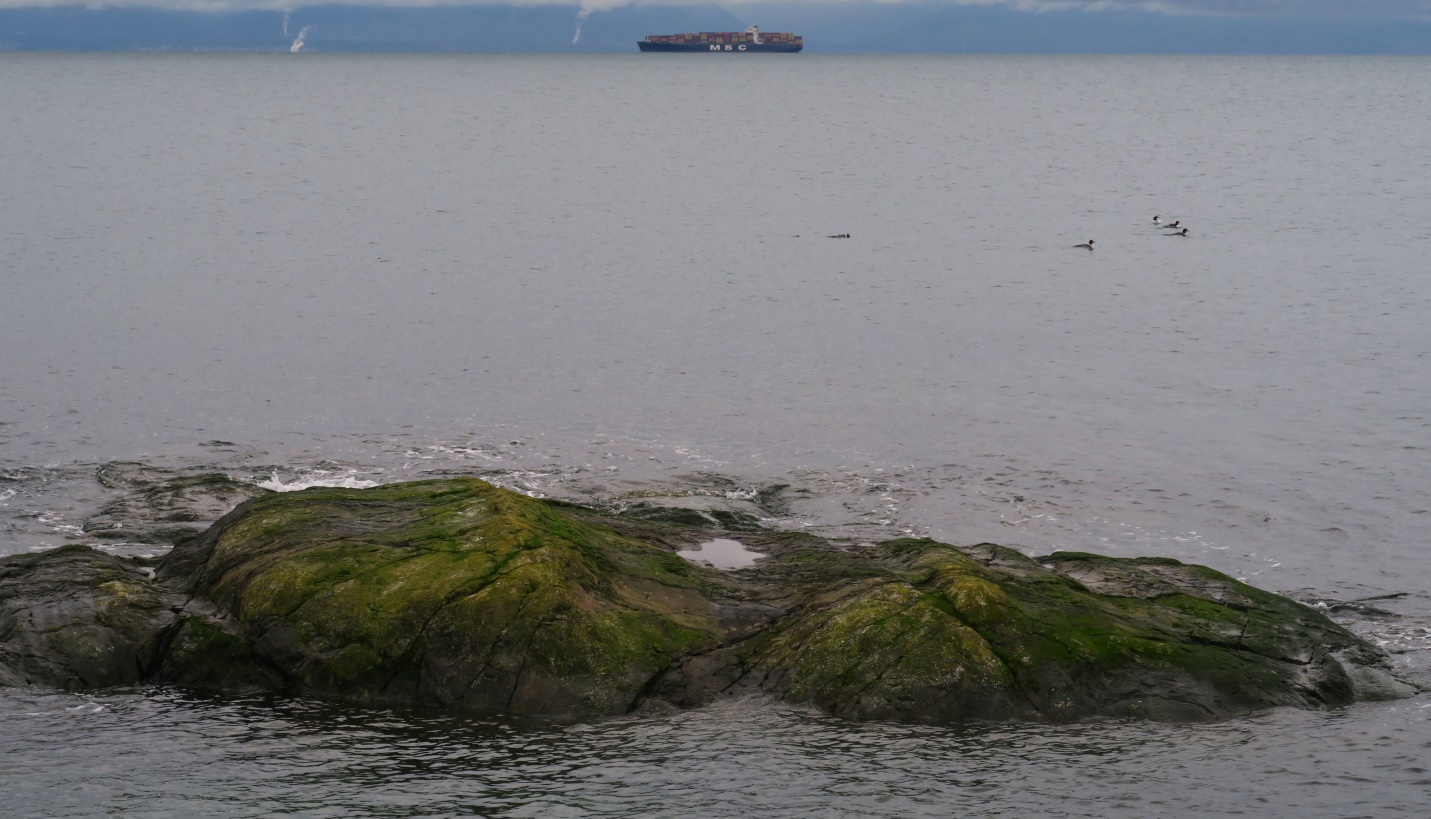
Figure 5: Even at extreme winter high tides when all other marine macroalgae are submerged, many patches of Prasiola meridionalis remain above the water line. Like the container ship and the Common Mergansers that are also featured in this picture, Emerald Carpet belongs with the water and as such receives enough ‘splashes’ and ‘spray’ to keep it vibrant. Harling Point, Juan de Fuca Strait, B.C., Canada. January 28, 2021. Photo ID 27449 ©Seaweedwhisperings.com
Biology & Natural History Information:
Description:
This green alga grows in groupings composed of many tiny, green, undivided blades that usually have curved and hood-like tips. These blades are only one cell thick, have short basal stalks, and grow to only about 8 mm long (in really positive conditions up to 1 cm long). Hundreds or thousands of these blades can cover rock looking much like an “Emerald Carpet”.
Habitat:
This seaweed is found on rocks in the high intertidal and also above the high water mark. It grows at higher locations than most other marine algae and is often found above even the uppermost acorn barnacles; these barnacles occupy the intertidal splash zones where they get wet infrequently and are adapted to get their oxygen from both air and seawater. In such relatively “dry” locations, Prasiola meridionalis is often is growing alongside black lichens and can be quite regularly coated in the droppings of gulls and other seabirds who find these “edge of the ocean” locations to be useful perches.
North Pacific Distribution:
Kurile Islands, Russia; the Bering Sea and North Pacific at the Aleutian Islands; continuing along the Alaskan coastline and down to southern British Columbia.
Remarks:
Emerald Carpet grows well near bird rookeries or on rocks where seabirds perch. It receives high levels of nitrogen from the bird guano deposited at such locations but phycologists are unclear if this algae exploits these concentrations of nitrogenous compounds or if it simply tolerates them. One thing is certain; few other types of seaweed can tolerate such nitrogen-rich habitats, instead they find it toxic. The origin of the species name, meridionalis, is from the Latin meaning found towards the south.
Classification:
Phylum: Chlorophyta
Class: Trebouxiophyceae
Order: Prasiolales
Family: Prasiolaceae
Genus: Prasiola
Species: Prasiola meridionalis Setchell & N.L.Gardner 1920
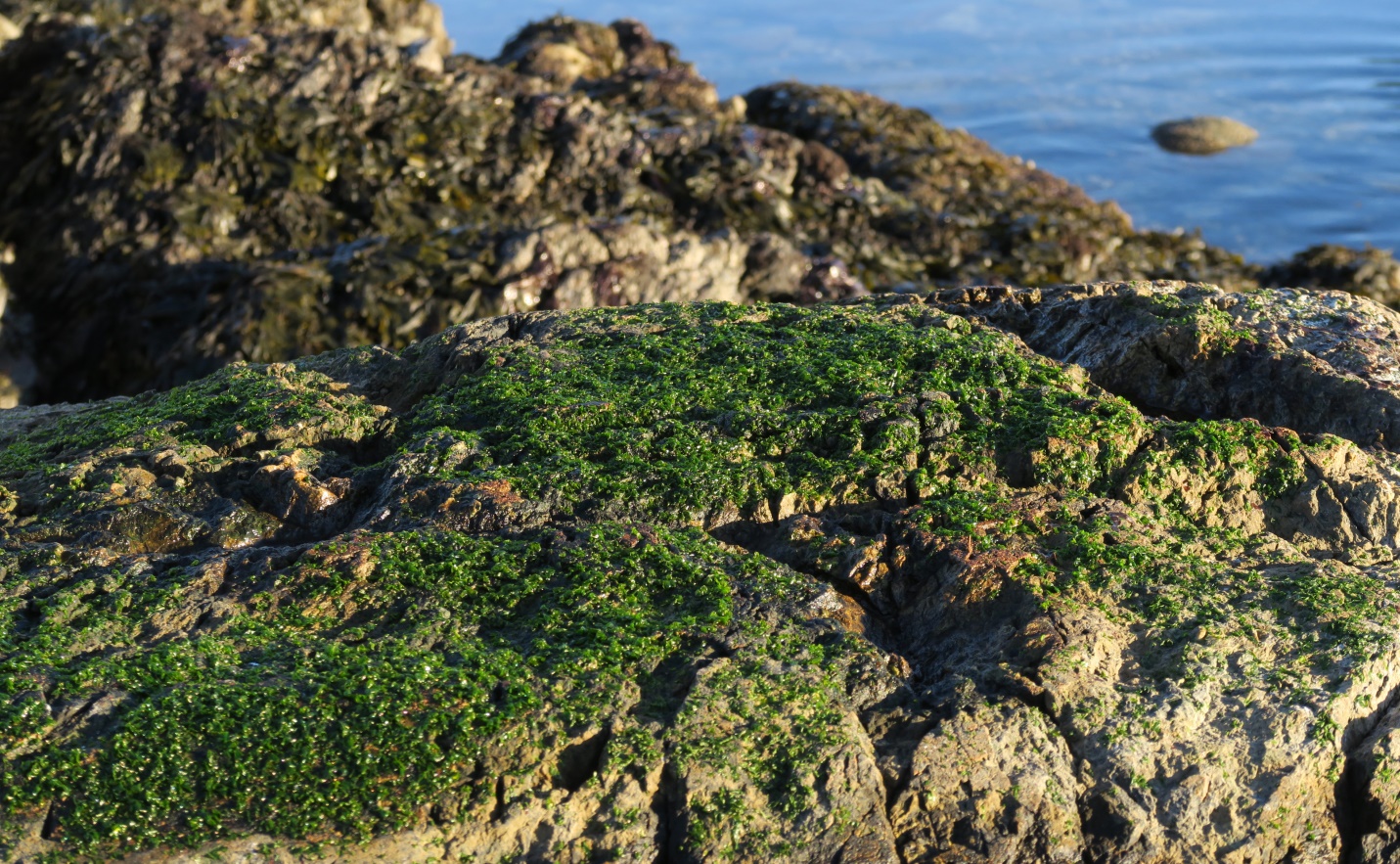
Figure 6: Prasiola meridionalis forms bright green carpets atop bedrock high in the intertidal zone. Harling Point, Juan de Fuca Strait, B.C., Canada. January 22, 2021. Photo ID 27450 ©Seaweedwhisperings.com
![]()
